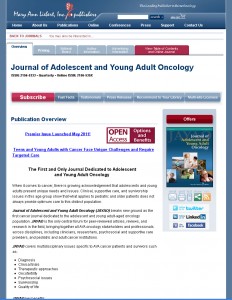 In the first volume of the Journal of Adolescent and Young Adult Oncology (JAYAO), a pioneering new cancer journal dedicated to the adolescent and young adult oncology population, an article by Oncofertility Consortium members Gwendolyn P. Quinn, PhD and Caprice A. Knapp, PhD entitled “Assessing the Reproductive Concerns of Children and Adolescents with Cancer: Challenges and Potential Solutions,” discusses the need for social science research in fertility preservation for adolescents with cancer. Knapp and Quinn consider the challenges in conducting research focused on the psychological reproductive concerns in the pediatric oncology population and offer solutions for them when possible.
In the first volume of the Journal of Adolescent and Young Adult Oncology (JAYAO), a pioneering new cancer journal dedicated to the adolescent and young adult oncology population, an article by Oncofertility Consortium members Gwendolyn P. Quinn, PhD and Caprice A. Knapp, PhD entitled “Assessing the Reproductive Concerns of Children and Adolescents with Cancer: Challenges and Potential Solutions,” discusses the need for social science research in fertility preservation for adolescents with cancer. Knapp and Quinn consider the challenges in conducting research focused on the psychological reproductive concerns in the pediatric oncology population and offer solutions for them when possible.
To begin, when clinicians and researchers are conducting studies on the adolescent cancer population, they are often forced to use the same measures of study that are used on adult patients. This is often not suitable for the adolescent population because it doesn’t correlate with their specific needs. This opens the door for a potential solution – creating new survey instruments that target this population. Devising new ways to measure outcomes can be time consuming and often it can be difficult to recruit young cancer patients to participate in these studies. Although there is not much we can do about timing, we can look to groups such as the Oncofertility Consortium to provide participants for the surveys as well as new ways to take measurements that are relevant to the constituent group being targeted.
Why is it so hard to get adolescent recruits for studies centered on reproductive concerns? Often it is because parents or legal guardians are the final decision-makers for their children and not all parents are comfortable with providers having fertility conversations with them. Although parents and providers both acknowledge that fertility is a concern for adolescents undergoing cancer treatment, they often disagree as to whether or not the adolescent should be informed about this risk. Parents want their children’s health restored and for them, that means their child being cancer free first and foremost. Parents also sometimes feel that their child may not be well-equipped to process both a cancer diagnosis and their potential loss of fertility so they choose not to burden their child with the former. Quinn and Knapp suggest that studies need to address the reasons that some parents do participate in these studies and the reasons why others don’t in an effort to determine “generalizability.”
Adolescents and children have specific needs when it comes to cancer treatment that differ from an adult’s trajectory. Fertility preservation can be hard for a young person to understand, but it is important nonetheless and more effective instrumentation is needed to assess the evolving needs of pediatric oncology patients. To read Quinn and Knapp’s entire article, “Assessing the Reproductive Concerns of Children and Adolescents with Cancer: Challenges and Potential Solutions,” click here.

